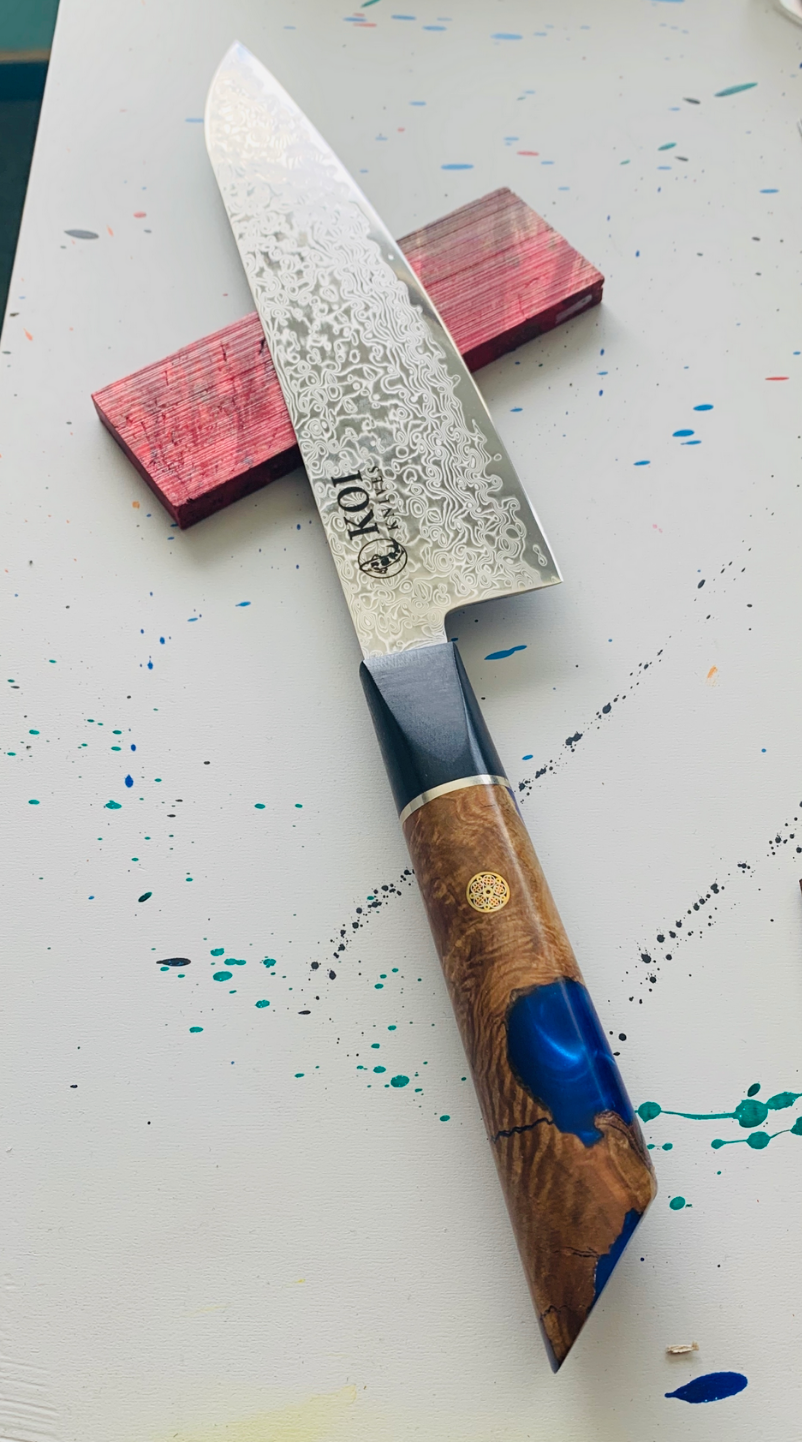The Gyuto knife, which loosely translates to “cow sword” is a general-purpose Japanese kitchen knife that is commonly used in the preparation of Western cuisine.
Like other western chef’s knives, Gyuto knives tend to have tall heels, a flatter profile towards the heels for chopping uses and a curve from the midsection towards their pointed tip suited for various rock-cutting uses. The pointed tip allows for delicate or precision cutting work or for making cuts in the harder to reach areas of the produce.
Gyuto kitchen knives are so versatile that there is almost no task in the kitchen they won’t tackle. For most home cooks and chefs, the Gyuto is often the only knife that they’ll need. While other specialized Japanese kitchen knives such as the Bunka, Deba or Kiritsuke knives will make your work easier for certain cutting, chopping or slicing tasks, the Gyuto should suffice in at least 90% of your kitchen needs.
If you need to prepare vegetables, you can use the flatter section towards the heels to chop or thrust-cut your vegetables. If you are handling stiffer produce, use their belly to rock-chop while the narrower pointed tips are for making those finer cuts.
Gyuto knives come not in just varying sizes and finishes but also in different variants. There are generally two types of Gyuto kitchen knives that you should acquaint yourself with: -
- Kiritsuke Gyuto
- Wa-Gyuto
Kiritsuke Gyuto
The Kiritsuke Gyuto knife is also referred to as the k-tip Gyuto knife. This is a Gyuto knife that has an angled ‘reverse tanto’ tip similar to the ones found in the Kiritsuke knives.
It has a different shape from the typical Gyuto kitchen knife. For example, instead of a belly or a curve from the midsection towards the tip, it has a flat edge so this is definitely not a kitchen knife that you can put to rocking or rock-cutting applications. However, these flatter edges make it ideal for the same cutting uses for which you would deploy a Santuko knife such as tap-chopping and push-cutting techniques. The k-tip allows you to cut with some delicacy and precision and reach tight corners but you shouldn’t put the tip into heavy cutting uses.
The k-tip Gyuto knives usually have similar blade lengths as the typical Gyuto knives which range from 240mm to 330mm. A 270mm Kiritsuke Gyuto knife can be a great alternative to the typical Gyuto knives. You can also use the k-tip Gyuto kitchen knives on different types of produce including meat, fish and vegetables.
Wa-Gyuto
Due to their widespread uses in Western kitchens, most Gyuto knives have western-style handles. Wa-Gyuto kitchen knives refers to Gyuto knives that have the traditional Japanese handles or ‘Wa-Handle’.
Unlike western handles which can be made from metal, plastic or composite materials, Wa-Handles are usually made from wood and the Wa-Gyuto kitchen knives therefore have a much lighter feel than the typical Gyuto kitchen knife. Due to the lighter handles, they also have a balance point that is more orientated towards the tip of the knife. This forward balance has its advantages as far as the efficacy of the cutting goes. A Wa-Handle allows the knife to do much of your work and that means less exertion on your part. Thanks to their forward balance, Wa-Gyuto kitchen knives are also easier to wield than the typical Gyuto with a western-style handle. This allows you to more easily direct the pointed tip of the blade when you are making those delicate or precision cuts. The key advantage that you get from the Japanese handle is that the knife becomes lighter, nimbler and more precise compared to a conventional Gyuto knife with a Western-style handle.
You can use the Wa-Gyuto kitchen knives with various cutting techniques. This versatility also enables these knives to handle wide-ranging kitchen tasks. They will easily glide through different kinds of produce including fruits, meats, fishes and vegetables.
However, the Wa-Gyuto is still a multipurpose kitchen knife just like the typical Gyuto knife. You can still use this lightweight Gyuto to rock-chop, make fine cuts and to slice different cuts of meat. If you wish to use it to make larger cuts on meat, you will need to use it in a back and forth sawing motion.
You can also use the Wa-Gyuto kitchen knives to push-cut the more muscular meats or to pull-cut softer meats. When you used for these purposes, your wrists will be pointing downwards with the shoulder raised during the cutting action.
Like the ‘conventional’ Gyuto, a shorter blade in a ‘Wa-Handle’ Gyuto kitchen knife makes the knife a lot nimbler while a longer blade gives the knife extra slicing power which makes it suited for the more muscular cutting or slicing uses.
Overall, the Wa-Gyuto is just as versatile as the typical Gyuto knife. In Japan, it is simply referred to as the wagyu knife or a Japanese Chef’s knife. It combines elements of both the Japanese and Western styles, attaching a Japanese knife-style handle onto a single material blade. Most Western chefs would be more familiar with the typical Gyuto kitchen knife and the Wa-Gyuto is built for the Japanese cuisine chefs. It can be used in various Japanese cuisines ranging from vegetables to meats.



